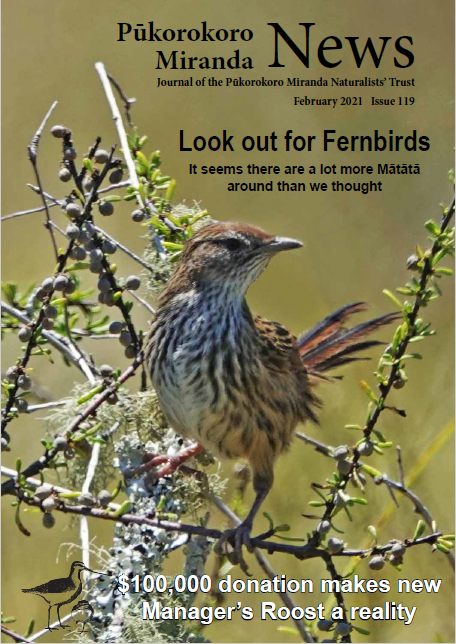Pūkorokoro Miranda News – February 2021 Issue 119
Our February 2021 issue of Pūkorokoro Miranda News follows Jim Eagles and family in a search along the Shorebird Coast for Fernbirds, an update on the transmitter carrying godwits and the progress on the Manager’s Roost. And more…
Discovering a profusion of Fernbirds
Jim Eagles and his family joined Department of Conservation ranger Ken Brown in an effort to discover whether there are Fernbirds/Mātātā along the coastal strip . . . and were amazed at what they found.
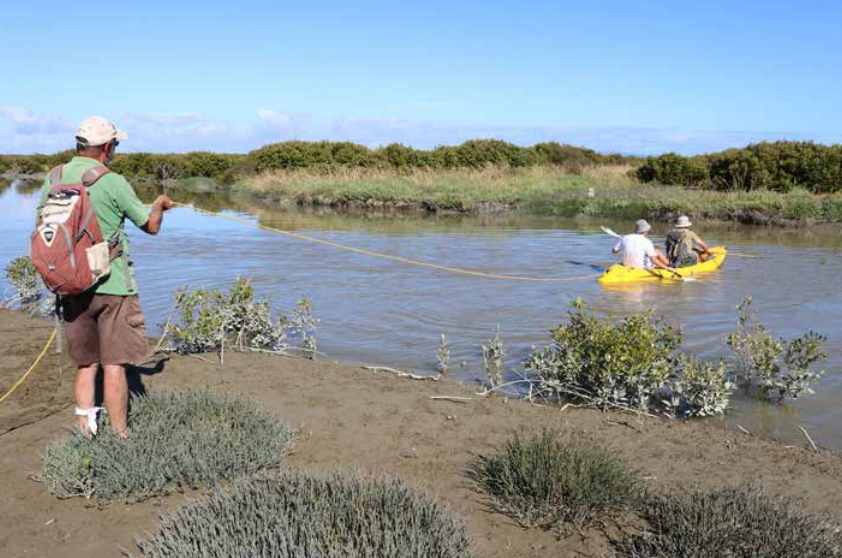
We were just about to retreat from the Umbrella Sedge jungle, dotted with patches of Ribbonwood and fringed by Mangroves, that seems to cover most of the Firth of Thames coastline between the Piako and Waihou River mouths, when Ken froze and pointed at a nearby bush. Seconds later I heard the distinctive ‘wheet’ call. Seconds after that I saw first one and then two dark brown shapes skulking through the foliage. I even got photos. We grinned in delight. Two more Fernbirds. That took our tally for a couple of hours to 11 definite sightings and at least six more heard, far more than we had expected, and very exciting.
We had gone to that area – helped part of the time by my daughter Alex and grandson Jamie – on the first stage of a project to put automatic call recorders along the coastline from the Shorebird Centre to the Waihou River to try to get a handle on the Fernbird population. Already, without even hearing the results of the six recorders that are in place so far, we know that numbers there are very healthy.
That has particular significance for PMNT because Ray Buckmaster, who is leading the project to restore the habitat on the Findlay Reserve, has declared the Fernbird to be its signature species: in other words, when Fernbirds return to the reserve we will know it is a success. Because of that I had started trying to find out whether there are any Fernbirds living close enough to return naturally or whether we might have to work towards a translocation. Looking through the records was not encouraging.
Fernbirds were once common in fern-covered flats and raupō wetlands across the whole of New Zealand. Māori knew Mātātā well, saw them as providing links with the gods and sometimes used them in ceremonies. In the 1870s the pioneer ornithologist Walter Buller described them as one of our commonest birds. But in the decades after that a combination of loss of habitat and the spread of mammalian predators saw numbers collapse. Today both the North Island and South Island subspecies are classified as at At Risk/Declining and the status of the other three subspecies is even worse.
You’d imagine that the Shorebird Coast would once have been prime Fernbird habitat and certainly in the 1940s Dick Sibson regularly recorded them in the manuka swamp which once surrounded the old Miranda hot pools. Former Trust chair Stuart Chambers recalls being taken to the pools by Dick in 1949 to hear them but adds, ‘With the building of the present pools in the 1960s and the subsequent development of the area into farmland the Fernbirds have left.’
Since then reported sightings in the area have been few and far between. A detailed search of Trust records by Stuart found a 1975 Bird Report mentioning Fernbirds on a farm at Kaiaua; four years later the Selected Species List had two at the old roosting site at Karito, on the coast near the hot pools, and three at Waitakaruru; the species list also recorded three at Waitakaruru in 1982; a 1991 Trust newsletter reported Pam Agnew seeing them at Karito; and a 1993 Newsletter recorded a sighting at the pump station
near Miranda Hot Springs.
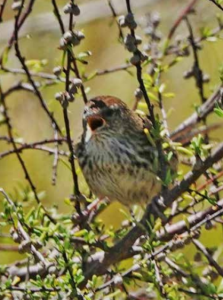
A Fernbird calling from a bush on the coast near Orongo 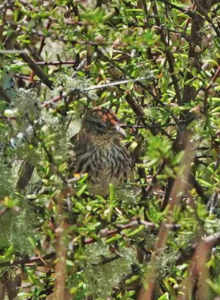
A Fernbird poking its head out of the bushes to see what’s going on
‘That was the last I heard of them,’ Stuart says. ‘I went looking but saw nothing.’ In an article written in the newsletter at the time he commented, ‘The scrubby fringes of manuka, flax and raupo, which are the normal habitat of this bird, have been progressively pushed back as new stopbanks and drainage systems closer to the mangrove edge have allowed farming to spread. Where Fernbirds once lived cattle now graze.’ Certainly, Birds NZ’s 1999-2004 WebAtlas, has no record of Fernbirds on the Shorebird Coast.
However, there is a lot of work being done to restore some of that lost habitat. Last year PMNT volunteers planted more than 11,000 grasses and shrubs on the Findlay Reserve and this year the plan is to plant even more. Similar work is being done on DOC’s Taramaire Wildlife Reserve opposite the Centre and there is the possibility of the same thing happening on the Tiaki Repo ki Pūkororo land over the road from the Findlay Reserve.
The plants going on to the Findlay Reserve are very much in line with the description of Fernbird habitat in Kevin Parker’s authoritative 2002 Master of Science thesis, Ecology and Management of North Island Fernbird, which studied the population in the Omaha Saltmarsh and also reported on the successful translocation of birds from a proposed motorway site near Orewa to Tiritiri Matangi Island.
Fernbirds prefer low, dense vegetation with emergent shrubs in swamps, saltmarshes and flats and the area Parker studied at Omaha is a narrow strip of coastal land ‘characterised by scattered Manuka, Marsh Ribbonwood (Plagianthus divaricatus), Flax (Phormium tenax), and New Zealand Broom (Carmichaelia spp.) with an understorey of Baumea juncea, Juncus krausii and Leptocarpus similis.
Where they are able to find such habitat Fernbirds build tidy nests which are usually less than 1m above ground and produce an average of 3-4 eggs. Males and females look very similar and they share the task of incubating the eggs and raising the young. However, the male does play the dominant role in defending the nesting area, though this usually involves calling and displaying and only rarely requires fighting or chasing.
Unlike well-behaved children, Fernbirds are generally heard but not seen, and they have a variety of calls. The most common call is a ‘u-tick’ which a pair will often produce alternately in a duet. The territorial challenge is a low chittering sound, which may last for several minutes. When foraging they also produce a loud ‘wheet’ noise.
They mainly eat insects (especially larvae, flies, beetles and moths), spiders and other small invertebrates, but are also known to enjoy fruit and seeds, and NZ Birds Online says there is one recorded case of a Fernbird eating a skink. Parker foung that spiders, particularly the common nursery web spider and its egg sacs, were the most frequently observed prey items. ‘An adult Fernbird was observed pecking into the side of a nursery web spider web, presumably to gain access to the adult spider or the egg sac. An adult Fernbird was also observed eating Marsh Ribbonwood berries on one occasion.’
Unfortunately, not only have Mātātā suffered massive habitat loss, they are also highly vulnerable to predators. There are documented cases of entire populations on small islands being wiped out by cats, rats and Weka. Studies have also identified birds like Kahu, Mynahs and Kōtare as predating Fernbird chicks.
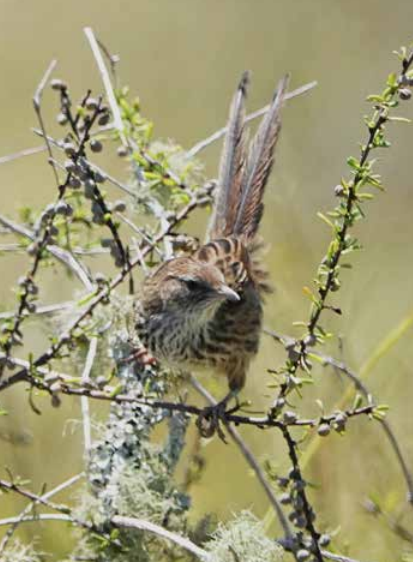
A Fernbird flies to the top of a Ribbonwood bush to check out the unexpected humans passing by 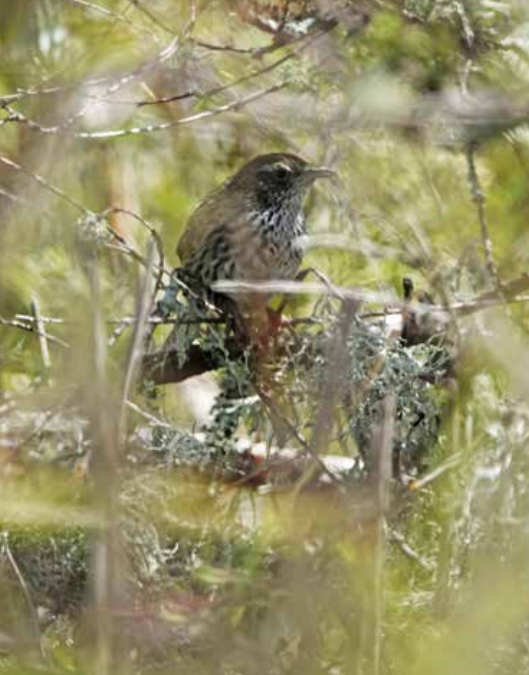
A Fernbird looks out from behind a screen of foliage 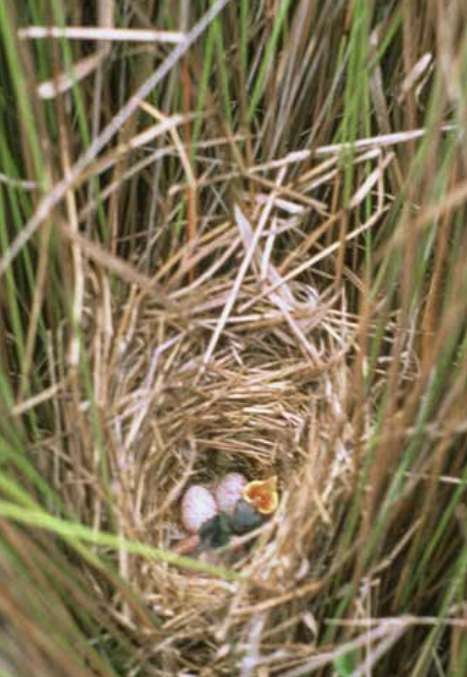
Fernbird nest
Parker’s study site at Omaha demonstrated just how vulnerable Fernbirds are. Even though the area was bounded on one side by the sea and on the other by a fence offering some protection from dogs, cats and possums, only half the 21 nests observed over two seasons successfully fledged chicks, mostly due to predation. Although it was not possible to conclusively identify the predators, the signs pointed very strongly to Stoats being responsible for the overwhelming majority of both egg and chick predation.
In addition, Parker carried out an experiment with artificial nests and eggs to try learn more about Fernbird predation and this mainly pointed the finger at mice. ‘The results of the artificial nest experiment suggest that mice are at least potential nest predators and may have a significant impact on Fernbird particularly at the laying and incubation stage,’ he concluded. ‘This impact may be more apparent when rat numbers are low. Mice may also be significant competitors for invertebrate foods.’
Another possible competitor for food, Parker suggested, could be the Asian Paper Wasp which consumes many of the same invertebrates. ‘If competition with Asian Paper Wasps for invertebrates is occurring, North Island Fernbird may require larger territories to obtain food, particularly when feeding young.’
So, given all those problems, what are our chances of bringing Mātātā back to the Shorebird Coast. Well, the general locality has been given a big tick by no less an authority than Kevin Parker who, since writing his thesis on Fernbirds, has become a consultant and presided over 50 translocations. A year back Kevin visited the Shorebird Coast and went for a walk with manager Keith Woodley across the coastal paddocks just north of the Centre.
As Keith recalls, ‘I was traversing familiar landscape: lumpy paddocks of shell ridges corrugated from years of stock grazing, covered in exotic grasses, interspersed with old fence lines and low lying fingers of salt marsh and sedges. Kevin was wearing different spectacles. He was visualising future Fernbird territories and estimated the land could support up to 20 of them.’
So what is the chance of that happening? Well, the right plants are going in the ground though they will take time to mature. And there are traps all along the coastline which, hopefully, will keep potential predators somewhat under control.
Unfortunately it’s not always easy to know where there are Fernbirds. For one thing, they’re usually described in guide books as ‘skulking’, ‘secretive’ or ‘sneaky’, in other words difficult to see. For another, the kind of habitat they enjoy now mainly survives in inaccessible areas, like the spots where we found them on the coast which had to be reached by crossing a deep, muddy, drainage ditch.
But in recent years there have been occasional sightings not far from Pūkorokoro. There are reports on eBird of Fernbirds beside the track just across the road from the Centre in 1994, beside the bridge at Waitakaruru in 2016 and close to the Stilt Hide in 2018. In May last year Ken Brown was ‘pretty sure’ he heard Fernbird calls alongside the Hauraki Cycle Trail near the mouth of the Piako River.
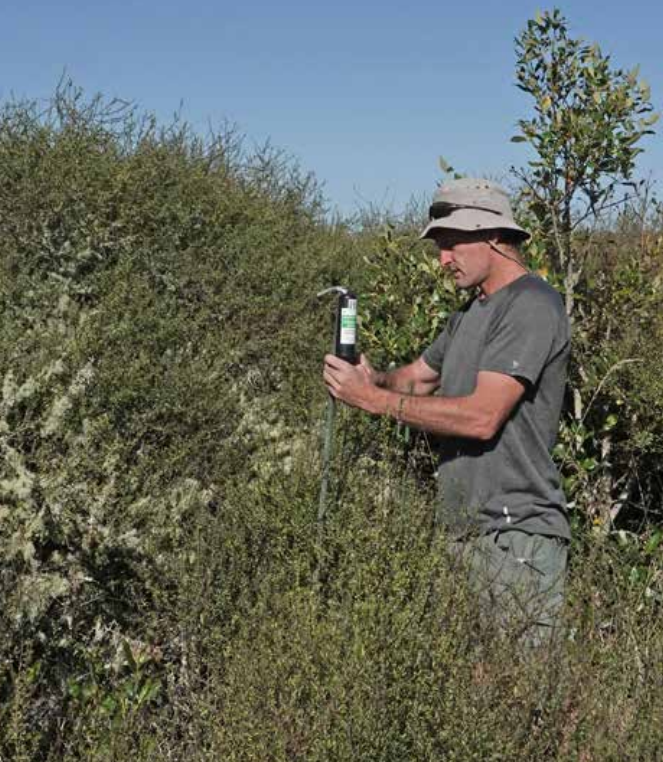
Then in July Russell Cannings recorded two sightings along the cycle trail near the new Piako Roost. ‘The birds I had were in the brackish wetland on the outside of the cycle trail dyke,’ he said. ‘I would imagine there is a steady breeding population as the tidal rushes, grasses, and Sarcornia seem like ideal habitat.’
Our recent foray into the coastal areas between the Piako and Waihou Rivers make it clear that Fernbirds are thriving in the mix of Umbrella Sedge, Ribbonwood and Mangroves found there and the numbers suggest that the coastal trapline – which has taken out a huge number of Ferrets – is working.
Once the planned line of call recorders is in place along the rest of the Shorebird Coast we’ll be able to get an idea of where the birds can be found. The recorders will turn on for two hours at both 6am and 6pm daily and record what is going on. When they are recovered the recordings will be scanned by special software to identify any bird calls. Hopefully they will provide more encouraging information.
Certainly there is some good habitat on the lower Waitakaruru River and at Karito which could allow expansion of the population along the coast to Pūkorokoro.
Fernbirds are not great fliers but, acording to the 1996 Field Guide to NZ Birds, ‘After becoming independent, juveniles roam away from their natal territory and can turn up in small scrub patches and wetlands 20-plus km from the nearest breeding birds.’ The Piako Roost, where they were sighted by Russell a few months ago, is less than 30km from the Centre.
As well as all our amazing shorebirds we’ve already got Spotless Crake, Banded Rail and Bittern in the area. Now there’s reason to think that Fernbirds may be spreading up the coast towards the new home we are creating for them. That’s reason to celebrate.
Other Articles in this Issue
Anonymous $100,000 donation makes new Manager’s Roost a reality
PMNT will definitely be able to put up a new 3-bedroom cottage for the centre manager this year following an amazing anonymous donation of $100,000.
If Botulism hits waterbirds and fish this summer conservation groups will be better prepared
Although this summer has been very dry, so far there hasn’t been a repeat of the botulism outbreak which killed several thousand birds, but if it does happen local councils, government agencies and volunteer groups will be better prepared.
So where are those the tagged godwits now?
An update from Adrian Riegen about the satellite tagged Godwits. Both the adults we had followed on their last migration and where the juveniles have settled around New Zealand.
Taking swabs from oystercatchers at both ends
As well as providing more information about what South Island Pied Oystercatchers get up to, the latest catch of the birds will also help research into whether our birds are a source of chlamydia.

